Deck 7: A Quantum Model of Atoms: Waves and Particles
Question
Question
Question
Question
Question
Question
Question
Question
Question
Question
Question
Question
Question
Question
Question
Question
Question
Question
Question
Question
Question
Question
Question
Question
Question
Question
Question
Question
Question
Question
Question
Question
Question
Question
Question
Question
Question
Question
Question
Question
Question
Question
Question
Question
Question
Question
Question
Question
Question
Question
Question
Question
Question
Question
Question
Question
Question
Question
Question
Question
Question
Question
Question
Question
Question
Question
Question
Question
Question
Question
Question
Question
Question
Question
Question
Question
Question
Question
Question
Question

Unlock Deck
Sign up to unlock the cards in this deck!
Unlock Deck
Unlock Deck
1/143
Play
Full screen (f)
Deck 7: A Quantum Model of Atoms: Waves and Particles
1
In refraction, polychromatic light is dispersed into its component wavelengths by ________
A) constructive and destructive interference of light waves in air.
B) internal reflections within a prism.
C) differences in the bending of different wavelengths of light by a prism.
D) constructive and destructive interference of light waves in a prism.
E) the reduction in the intensity of white light to reveal the colors.
A) constructive and destructive interference of light waves in air.
B) internal reflections within a prism.
C) differences in the bending of different wavelengths of light by a prism.
D) constructive and destructive interference of light waves in a prism.
E) the reduction in the intensity of white light to reveal the colors.
differences in the bending of different wavelengths of light by a prism.
2
Which of the following is quantized?
A) the trajectory of a baseball hit from home plate
B) the speed of a Formula 1 race car
C) the diameter of a redwood tree
D) the number of marbles in a bag
E) your age
A) the trajectory of a baseball hit from home plate
B) the speed of a Formula 1 race car
C) the diameter of a redwood tree
D) the number of marbles in a bag
E) your age
the number of marbles in a bag
3
What is the wavelength ( , in m) of a radio station operating at a frequency of 99.6 MHz?
A) 3.01 * 106 m
B) 3.01 m
C) 3.32 *10 10-7 m
D) 0.332 m
E) 3.32 m
A) 3.01 * 106 m
B) 3.01 m
C) 3.32 *10 10-7 m
D) 0.332 m
E) 3.32 m
3.01 m
4
Which of the following occurs only in discrete (quantized) increments?
A) the speed a car drives on the interstate
B) the altitude that an airplane flies
C) time
D) the level of water in a sink
E) money
A) the speed a car drives on the interstate
B) the altitude that an airplane flies
C) time
D) the level of water in a sink
E) money

Unlock Deck
Unlock for access to all 143 flashcards in this deck.
Unlock Deck
k this deck
5
The fact that the absorption and emission spectra of atoms and their ions are different is evidence that the spectra are due to ________
A) electrons.
B) protons.
C) neutrons.
D) the nuclei.
E) electromagnetic interactions.
A) electrons.
B) protons.
C) neutrons.
D) the nuclei.
E) electromagnetic interactions.

Unlock Deck
Unlock for access to all 143 flashcards in this deck.
Unlock Deck
k this deck
6
In comparing the dark Fraunhofer lines with light emitted by elements in a flame, Bunsen and Kirchhoff demonstrated that ________
A) atoms emit and absorb electromagnetic radiation at characteristic wavelengths.
B) the solar spectrum has dark lines.
C) helium may be found in minerals that contain uranium.
D) electrons are responsible for the absorption and emission of electromagnetic radiation.
E) the solar spectrum has bright lines.
A) atoms emit and absorb electromagnetic radiation at characteristic wavelengths.
B) the solar spectrum has dark lines.
C) helium may be found in minerals that contain uranium.
D) electrons are responsible for the absorption and emission of electromagnetic radiation.
E) the solar spectrum has bright lines.

Unlock Deck
Unlock for access to all 143 flashcards in this deck.
Unlock Deck
k this deck
7
The Fraunhofer lines are evidence that ________
A) atoms contain nuclei.
B) atoms contain electrons.
C) waves interfere constructively.
D) elements absorb light.
E) elements emit light.
A) atoms contain nuclei.
B) atoms contain electrons.
C) waves interfere constructively.
D) elements absorb light.
E) elements emit light.

Unlock Deck
Unlock for access to all 143 flashcards in this deck.
Unlock Deck
k this deck
8
Atomic spectra are due to the changes in the energy of ________
A) protons.
B) neutrons.
C) nuclei.
D) electrons.
E) electromagnetic radiation.
A) protons.
B) neutrons.
C) nuclei.
D) electrons.
E) electromagnetic radiation.

Unlock Deck
Unlock for access to all 143 flashcards in this deck.
Unlock Deck
k this deck
9
The emission spectra of Na and Na+ are different because ________
A) Na+ has fewer electrons.
B) Na has fewer electrons.
C) Na+ has more protons.
D) Na has fewer neutrons.
E) Na has more protons.
A) Na+ has fewer electrons.
B) Na has fewer electrons.
C) Na+ has more protons.
D) Na has fewer neutrons.
E) Na has more protons.

Unlock Deck
Unlock for access to all 143 flashcards in this deck.
Unlock Deck
k this deck
10
Fraunhofer lines are due to ________
A) emission of radiation.
B) absorption of radiation.
C) the photoelectric effect.
D) constructive interference.
E) destructive interference.
A) emission of radiation.
B) absorption of radiation.
C) the photoelectric effect.
D) constructive interference.
E) destructive interference.

Unlock Deck
Unlock for access to all 143 flashcards in this deck.
Unlock Deck
k this deck
11
Which statement about electromagnetic radiation is not correct?
A) Electromagnetic radiation consists of oscillating electric and magnetic fields.
B) Electromagnetic radiation is emitted by all stars.
C) All electromagnetic radiation is visible to the eye.
D) Electromagnetic radiation spans a very wide range of wavelengths from gamma rays to radio waves.
E) The frequency and wavelength of electromagnetic radiation are related to each other.
A) Electromagnetic radiation consists of oscillating electric and magnetic fields.
B) Electromagnetic radiation is emitted by all stars.
C) All electromagnetic radiation is visible to the eye.
D) Electromagnetic radiation spans a very wide range of wavelengths from gamma rays to radio waves.
E) The frequency and wavelength of electromagnetic radiation are related to each other.

Unlock Deck
Unlock for access to all 143 flashcards in this deck.
Unlock Deck
k this deck
12
What color will a red object appear when it is seen through a filter with the absorption spectrum shown below? 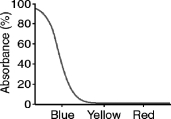
A) blue
B) yellow
C) red
D) black
E) white

A) blue
B) yellow
C) red
D) black
E) white

Unlock Deck
Unlock for access to all 143 flashcards in this deck.
Unlock Deck
k this deck
13
Which of the following types of electromagnetic radiation has the longest wavelength?
A) gamma rays
B) X-rays
C) radio waves
D) infrared
E) visible
A) gamma rays
B) X-rays
C) radio waves
D) infrared
E) visible

Unlock Deck
Unlock for access to all 143 flashcards in this deck.
Unlock Deck
k this deck
14
Which of the following types of electromagnetic radiation has the shortest wavelength?
A) gamma rays
B) X-rays
C) radio waves
D) infrared
E) visible
A) gamma rays
B) X-rays
C) radio waves
D) infrared
E) visible

Unlock Deck
Unlock for access to all 143 flashcards in this deck.
Unlock Deck
k this deck
15
Which of the following photons has the lowest frequency?
A) a photon from a Nd:YAG laser with = 1,064 nm
B) a photon from an Ar+ laser with = 514.5 nm
C) a photon from a Kr+ laser with = 647 nm
D) a photon from an ArF laser with = 193 nm
E) a photon from a He-Ne laser with = 633 nm
A) a photon from a Nd:YAG laser with = 1,064 nm
B) a photon from an Ar+ laser with = 514.5 nm
C) a photon from a Kr+ laser with = 647 nm
D) a photon from an ArF laser with = 193 nm
E) a photon from a He-Ne laser with = 633 nm

Unlock Deck
Unlock for access to all 143 flashcards in this deck.
Unlock Deck
k this deck
16
What color will a yellow object appear when it is seen through a filter with the absorption spectrum shown below? 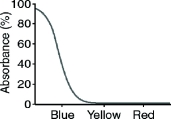
A) blue
B) yellow
C) red
D) black
E) white

A) blue
B) yellow
C) red
D) black
E) white

Unlock Deck
Unlock for access to all 143 flashcards in this deck.
Unlock Deck
k this deck
17
Which of the following photons has the highest frequency?
A) a photon from a Nd:YAG laser with = 1,064 nm
B) a photon from an Ar+ laser with = 514.5 nm
C) a photon from a Kr+ laser with = 647 nm
D) a photon from an ArF laser with = 193 nm
E) a photon from a He-Ne laser with = 633 nm
A) a photon from a Nd:YAG laser with = 1,064 nm
B) a photon from an Ar+ laser with = 514.5 nm
C) a photon from a Kr+ laser with = 647 nm
D) a photon from an ArF laser with = 193 nm
E) a photon from a He-Ne laser with = 633 nm

Unlock Deck
Unlock for access to all 143 flashcards in this deck.
Unlock Deck
k this deck
18
What color will a blue object appear when it is seen through a filter with the absorption spectrum shown below? 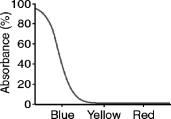
A) blue
B) yellow
C) red
D) black
E) white

A) blue
B) yellow
C) red
D) black
E) white

Unlock Deck
Unlock for access to all 143 flashcards in this deck.
Unlock Deck
k this deck
19
Which statement about refraction or diffraction is not correct?
A) A beam of light is bent or refracted as it moves from air into a denser medium such as water or a glass prism.
B) When a beam of light passes through a narrow slit, it is bent or diffracted by the edges and spreads out in a circular pattern.
C) When a beam of light is diffracted by two slits that are close to each other, the two sets of resulting waves interfere with each other, producing a pattern of light and dark bands.
D) When the crests of two waves overlap, they interfere constructively and produce a light band in the interference pattern.
E) When the crest of one wave overlaps with the trough of another, they are said to be "in phase."
A) A beam of light is bent or refracted as it moves from air into a denser medium such as water or a glass prism.
B) When a beam of light passes through a narrow slit, it is bent or diffracted by the edges and spreads out in a circular pattern.
C) When a beam of light is diffracted by two slits that are close to each other, the two sets of resulting waves interfere with each other, producing a pattern of light and dark bands.
D) When the crests of two waves overlap, they interfere constructively and produce a light band in the interference pattern.
E) When the crest of one wave overlaps with the trough of another, they are said to be "in phase."

Unlock Deck
Unlock for access to all 143 flashcards in this deck.
Unlock Deck
k this deck
20
What is the frequency (v, in Hz) of the photons emitted by a He-Ne laser with a wavelength ( ) of 632.8 nm?
A) 4.738 * 105 Hz
B) 1.897 * 102 Hz
C) 1.897 *1011 Hz
D) 4.738 * 1014 Hz
E) 1.897 * 1014 Hz
A) 4.738 * 105 Hz
B) 1.897 * 102 Hz
C) 1.897 *1011 Hz
D) 4.738 * 1014 Hz
E) 1.897 * 1014 Hz

Unlock Deck
Unlock for access to all 143 flashcards in this deck.
Unlock Deck
k this deck
21
The study of light emitted by the hydrogen atom by Johann Balmer, Johannes Rydberg, Niels Bohr, and others revolutionized physics because it revealed that ________
A) energy is quantized.
B) light intensity does not affect the number of atoms excited.
C) the emitted light is produced by the electron making a transition between quantized energy levels.
D) blackbody radiation is continuous.
E) atomic spectra are continuous.
A) energy is quantized.
B) light intensity does not affect the number of atoms excited.
C) the emitted light is produced by the electron making a transition between quantized energy levels.
D) blackbody radiation is continuous.
E) atomic spectra are continuous.

Unlock Deck
Unlock for access to all 143 flashcards in this deck.
Unlock Deck
k this deck
22
What is the minimum frequency of a photon that can eject a photoelectron from Ba metal? (The work function of barium is  = 4.3 *10-19 J.)
= 4.3 *10-19 J.)
A) 2.8 *10-52 Hz
B) 6.5 * 1014 Hz
C) 6.5 * 104 Hz
D) 6.5 * 1013 Hz
E) 2.8 * 1014 Hz
 = 4.3 *10-19 J.)
= 4.3 *10-19 J.)A) 2.8 *10-52 Hz
B) 6.5 * 1014 Hz
C) 6.5 * 104 Hz
D) 6.5 * 1013 Hz
E) 2.8 * 1014 Hz

Unlock Deck
Unlock for access to all 143 flashcards in this deck.
Unlock Deck
k this deck
23
Based on the following graph, which metal will emit the highest energy photoelectron when a photon with a frequency of 3.9*1014 Hz is incident on the metal? 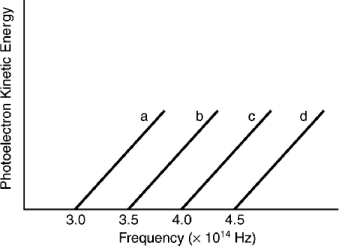
A) a
B) b
C) c
D) d

A) a
B) b
C) c
D) d

Unlock Deck
Unlock for access to all 143 flashcards in this deck.
Unlock Deck
k this deck
24
Indicate which of the following sources produces the lowest energy photons.
A) a radio station with v = 106.7 MHz
B) a dentist's X-ray source with = 100 pm
C) the laser in a CD player with = 650 nm
D) a microwave oven with v = 6.0 * 1010 Hz
E) your cell phone with v = 1.750 GHz
A) a radio station with v = 106.7 MHz
B) a dentist's X-ray source with = 100 pm
C) the laser in a CD player with = 650 nm
D) a microwave oven with v = 6.0 * 1010 Hz
E) your cell phone with v = 1.750 GHz

Unlock Deck
Unlock for access to all 143 flashcards in this deck.
Unlock Deck
k this deck
25
Which of the following will lead to an increase in the kinetic energies of photoelectrons emitted when light is incident on a metal surface?
A) decrease in the light's wavelength
B) increase in the light's intensity
C) increase in the light's wavelength
D) decrease in the light's frequency
E) decrease in the light's intensity
A) decrease in the light's wavelength
B) increase in the light's intensity
C) increase in the light's wavelength
D) decrease in the light's frequency
E) decrease in the light's intensity

Unlock Deck
Unlock for access to all 143 flashcards in this deck.
Unlock Deck
k this deck
26
An atom in its ground state absorbs a single photon of light and then relaxes back to the ground state by emitting an infrared photon (1,200 nm) followed by an orange photon (600 nm). What is the wavelength of the photon that was absorbed initially? 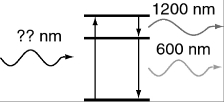
A) 600 nm
B) 1,200 nm
C) 1,800 nm
D) 900 nm
E) 400 nm

A) 600 nm
B) 1,200 nm
C) 1,800 nm
D) 900 nm
E) 400 nm

Unlock Deck
Unlock for access to all 143 flashcards in this deck.
Unlock Deck
k this deck
27
What is the photon energy of the yellow-orange light ( = 589 nm) produced by sodium vapor streetlights?
A) 3.37 *10-19 J
B) 6.63 *10-18 J
C) 2.99*10-20 J
D) 1.45 *10-17 J
E) 7.45 * 10-16 J
A) 3.37 *10-19 J
B) 6.63 *10-18 J
C) 2.99*10-20 J
D) 1.45 *10-17 J
E) 7.45 * 10-16 J

Unlock Deck
Unlock for access to all 143 flashcards in this deck.
Unlock Deck
k this deck
28
Based on the following graph, which metal will emit the highest energy photoelectron when a photon with a wavelength of 650 nm is incident on the metal? 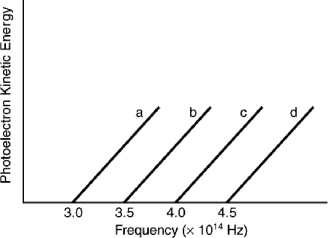
A) a
B) b
C) c
D) d

A) a
B) b
C) c
D) d

Unlock Deck
Unlock for access to all 143 flashcards in this deck.
Unlock Deck
k this deck
29
What is the energy (E, in J) of a photon from a microwave oven with a frequency of
v = 6.0 * 1010 Hz?
A) 3.98 *10 10-30 J
B) 3.98 *10-39 J
C) 3.98*10-23 J
D) 3.98 *10-17 J
E) 3.98 *10-13 J
v = 6.0 * 1010 Hz?
A) 3.98 *10 10-30 J
B) 3.98 *10-39 J
C) 3.98*10-23 J
D) 3.98 *10-17 J
E) 3.98 *10-13 J

Unlock Deck
Unlock for access to all 143 flashcards in this deck.
Unlock Deck
k this deck
30
Indicate which metal requires the shortest wavelength photons to eject photoelectrons based on the following graph. 
A) a
B) b
C) c
D) d

A) a
B) b
C) c
D) d

Unlock Deck
Unlock for access to all 143 flashcards in this deck.
Unlock Deck
k this deck
31
If each of the following metals is exposed to light with a wavelength of 240 nm, which will emit photoelectrons with the greatest kinetic energy?
A) iron ( = 7.2 *10-19 J)
= 7.2 *10-19 J)
B) platinum (11ef1a66_0479_eb58_a3cb_57e06677e6de_TB3834_11 = 9.1 *10-19 J)
C) nickel (11ef1a66_0479_eb58_a3cb_57e06677e6de_TB3834_11 = 8.3 *10-19 J)
D) palladium (11ef1a66_0479_eb58_a3cb_57e06677e6de_TB3834_11 = 8.2 *10-19 J)
E) sodium (11ef1a66_0479_eb58_a3cb_57e06677e6de_TB3834_11 = 4.4 *10-19 J)
A) iron (
 = 7.2 *10-19 J)
= 7.2 *10-19 J)B) platinum (11ef1a66_0479_eb58_a3cb_57e06677e6de_TB3834_11 = 9.1 *10-19 J)
C) nickel (11ef1a66_0479_eb58_a3cb_57e06677e6de_TB3834_11 = 8.3 *10-19 J)
D) palladium (11ef1a66_0479_eb58_a3cb_57e06677e6de_TB3834_11 = 8.2 *10-19 J)
E) sodium (11ef1a66_0479_eb58_a3cb_57e06677e6de_TB3834_11 = 4.4 *10-19 J)

Unlock Deck
Unlock for access to all 143 flashcards in this deck.
Unlock Deck
k this deck
32
Which of the following sources produces the highest energy photons?
A) a doctor's X-ray source
B) the heat lamp in your bathroom
C) a microwave oven
D) gamma rays from a star
E) radio waves from your local station
A) a doctor's X-ray source
B) the heat lamp in your bathroom
C) a microwave oven
D) gamma rays from a star
E) radio waves from your local station

Unlock Deck
Unlock for access to all 143 flashcards in this deck.
Unlock Deck
k this deck
33
Indicate which of the following photons can cause emission of photoelectrons from a surface of gallium ( = 6.7 *10-19 J).
= 6.7 *10-19 J).
A) 350 nm
B) 400 nm
C) 200 nm
D) 650 nm
E) 500 nm
 = 6.7 *10-19 J).
= 6.7 *10-19 J).A) 350 nm
B) 400 nm
C) 200 nm
D) 650 nm
E) 500 nm

Unlock Deck
Unlock for access to all 143 flashcards in this deck.
Unlock Deck
k this deck
34
The work function of sodium is  = 2.9 * 10-19 J. What is the maximum wavelength that can cause ejection of photoelectrons from a sodium surface?
= 2.9 * 10-19 J. What is the maximum wavelength that can cause ejection of photoelectrons from a sodium surface?
A) 151 nm
B) 222 nm
C) 45.1 nm
D) 451 nm
E) 685 nm
 = 2.9 * 10-19 J. What is the maximum wavelength that can cause ejection of photoelectrons from a sodium surface?
= 2.9 * 10-19 J. What is the maximum wavelength that can cause ejection of photoelectrons from a sodium surface?A) 151 nm
B) 222 nm
C) 45.1 nm
D) 451 nm
E) 685 nm

Unlock Deck
Unlock for access to all 143 flashcards in this deck.
Unlock Deck
k this deck
35
Which of the following photons has the lowest energy?
A) a photon from a Nd:YAG laser with = 1,064 nm
B) a photon from an Ar+ laser with = 514.5 nm
C) a photon from a Kr+ laser with = 647 nm
D) a photon from an ArF laser with = 193 nm
E) a photon from a He-Ne laser with = 633 nm
A) a photon from a Nd:YAG laser with = 1,064 nm
B) a photon from an Ar+ laser with = 514.5 nm
C) a photon from a Kr+ laser with = 647 nm
D) a photon from an ArF laser with = 193 nm
E) a photon from a He-Ne laser with = 633 nm

Unlock Deck
Unlock for access to all 143 flashcards in this deck.
Unlock Deck
k this deck
36
What is the energy (E, in J) of the photons emitted by an Ar+ laser with a wavelength of = 488 nm?
A) 2.46 * 1018 J
B) 9.69 *10-23 J
C) 1.36 *10-36 J
D) 4.07 *10-19 J
E) 2.46 * 10-18 J
A) 2.46 * 1018 J
B) 9.69 *10-23 J
C) 1.36 *10-36 J
D) 4.07 *10-19 J
E) 2.46 * 10-18 J

Unlock Deck
Unlock for access to all 143 flashcards in this deck.
Unlock Deck
k this deck
37
Which of the following photons has the highest energy?
A) a photon from a Nd:YAG laser with = 1,064 nm
B) a photon from an Ar+ laser with = 514.5 nm
C) a photon from a Kr+ laser with = 647 nm
D) a photon from an ArF laser with = 193 nm
E) a photon from a He-Ne laser with = 633 nm
A) a photon from a Nd:YAG laser with = 1,064 nm
B) a photon from an Ar+ laser with = 514.5 nm
C) a photon from a Kr+ laser with = 647 nm
D) a photon from an ArF laser with = 193 nm
E) a photon from a He-Ne laser with = 633 nm

Unlock Deck
Unlock for access to all 143 flashcards in this deck.
Unlock Deck
k this deck
38
Indicate which of the following sources produces the highest energy photons.
A) a radio station with = 106.7 MHz
B) a dentist's X-ray source with = 100 pm
C) the laser in a CD player with = 650 nm
D) a microwave oven with v= 6.0 * 1010 Hz
E) your cell phone with v = 1.750 GHz
A) a radio station with = 106.7 MHz
B) a dentist's X-ray source with = 100 pm
C) the laser in a CD player with = 650 nm
D) a microwave oven with v= 6.0 * 1010 Hz
E) your cell phone with v = 1.750 GHz

Unlock Deck
Unlock for access to all 143 flashcards in this deck.
Unlock Deck
k this deck
39
Which of the following sources produces the lowest energy photons?
A) a doctor's X-ray source
B) the heat lamp in your bathroom
C) a microwave oven
D) gamma rays from a star
E) radio waves from your local station
A) a doctor's X-ray source
B) the heat lamp in your bathroom
C) a microwave oven
D) gamma rays from a star
E) radio waves from your local station

Unlock Deck
Unlock for access to all 143 flashcards in this deck.
Unlock Deck
k this deck
40
The studies of light emitted by hot objects (Max Planck) and the photoelectric effect (Albert Einstein) revolutionized physics because they revealed ________
A) that energy is quantized.
B) that light intensity does not affect the number of electrons ejected from a metal.
C) that atomic spectra are due to the quantized transitions of electrons.
D) that blackbody radiation is continuous.
E) that atomic spectra are continuous.
A) that energy is quantized.
B) that light intensity does not affect the number of electrons ejected from a metal.
C) that atomic spectra are due to the quantized transitions of electrons.
D) that blackbody radiation is continuous.
E) that atomic spectra are continuous.

Unlock Deck
Unlock for access to all 143 flashcards in this deck.
Unlock Deck
k this deck
41
How much energy is required to ionize a He+ ion in its ground state?
A) 2.18 * 10-18 J
B) 4.36 *10-18 J
C) 8.72 *10-18 J
D) 1.74 *10-18 J
A) 2.18 * 10-18 J
B) 4.36 *10-18 J
C) 8.72 *10-18 J
D) 1.74 *10-18 J

Unlock Deck
Unlock for access to all 143 flashcards in this deck.
Unlock Deck
k this deck
42
Which of the transitions in the hydrogen atom energy-level diagram shown here is not possible? 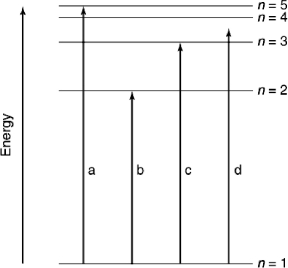
A) a
B) b
C) c
D) d

A) a
B) b
C) c
D) d

Unlock Deck
Unlock for access to all 143 flashcards in this deck.
Unlock Deck
k this deck
43
Electromagnetic radiation with a frequency of 8.6 *1014 Hz incident on an unknown metal surface causes ejection of photoelectrons with kinetic energies of 1.3 *10-19 J. What is the unknown metal?
A) rubidium ( = 3.5 *10-19 J)
= 3.5 *10-19 J)
B) gold (11ef1a66_0479_eb58_a3cb_57e06677e6de_TB3834_11 = 8.2 *10-19 J)
C) nickel (11ef1a66_0479_eb58_a3cb_57e06677e6de_TB3834_11 = 8.3 *10-19 J)
D) sodium (11ef1a66_0479_eb58_a3cb_57e06677e6de_TB3834_11 = 4.4 *10-19 J)
E) platinum (11ef1a66_0479_eb58_a3cb_57e06677e6de_TB3834_11 = 9.1 *10-19 J)
A) rubidium (
 = 3.5 *10-19 J)
= 3.5 *10-19 J)B) gold (11ef1a66_0479_eb58_a3cb_57e06677e6de_TB3834_11 = 8.2 *10-19 J)
C) nickel (11ef1a66_0479_eb58_a3cb_57e06677e6de_TB3834_11 = 8.3 *10-19 J)
D) sodium (11ef1a66_0479_eb58_a3cb_57e06677e6de_TB3834_11 = 4.4 *10-19 J)
E) platinum (11ef1a66_0479_eb58_a3cb_57e06677e6de_TB3834_11 = 9.1 *10-19 J)

Unlock Deck
Unlock for access to all 143 flashcards in this deck.
Unlock Deck
k this deck
44
Early photoelectric light detectors were based on cesium. Cesium metal has a work function of 3.43 *10-19 J. What is the minimum frequency of electromagnetic radiation required to eject photoelectrons from a cesium surface?
A) 1.75 *1014/s
B) 3.15 * 1014/s
C) 5.17 * 1014/s
D) 1.55 * 1013/s
E) 7.24 * 1015/s
A) 1.75 *1014/s
B) 3.15 * 1014/s
C) 5.17 * 1014/s
D) 1.55 * 1013/s
E) 7.24 * 1015/s

Unlock Deck
Unlock for access to all 143 flashcards in this deck.
Unlock Deck
k this deck
45
Early photoelectric light detectors were based on cesium. Cesium metal has a work function of 3.43 *10-19 J. What is the longest wavelength of light that could be detected with one of these detectors?
A) 759 nm
B) 579 nm
C) 679 nm
D) 767 nm
E) 455 nm
A) 759 nm
B) 579 nm
C) 679 nm
D) 767 nm
E) 455 nm

Unlock Deck
Unlock for access to all 143 flashcards in this deck.
Unlock Deck
k this deck
46
Determine the wavelength of the line in the hydrogen atom spectrum corresponding to the n1 = 3 to n2 = 4 transition.
A) 1,094 nm
B) 1,875 nm
C) 656 nm
D) 335 nm
E) 109 nm
A) 1,094 nm
B) 1,875 nm
C) 656 nm
D) 335 nm
E) 109 nm

Unlock Deck
Unlock for access to all 143 flashcards in this deck.
Unlock Deck
k this deck
47
Which of the transitions in the hydrogen atom energy-level diagram shown here requires the longest wavelength photon? 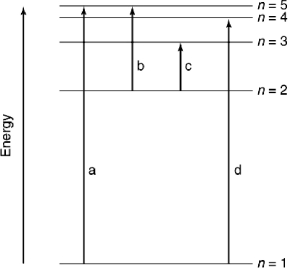
A) a
B) b
C) c
D) d

A) a
B) b
C) c
D) d

Unlock Deck
Unlock for access to all 143 flashcards in this deck.
Unlock Deck
k this deck
48
What is the kinetic energy of the photoelectrons emitted from a sodium surface ( = 2.9 *10-19 J) when it is irradiated by photons with a wavelength of 350 nm?
= 2.9 *10-19 J) when it is irradiated by photons with a wavelength of 350 nm?
A) 2.9 *10-19 J
B) 5.7 *10-19 J
C) 0 J
D) 2.8 *10-19 J
E) 3.6 * 10-19 J
 = 2.9 *10-19 J) when it is irradiated by photons with a wavelength of 350 nm?
= 2.9 *10-19 J) when it is irradiated by photons with a wavelength of 350 nm?A) 2.9 *10-19 J
B) 5.7 *10-19 J
C) 0 J
D) 2.8 *10-19 J
E) 3.6 * 10-19 J

Unlock Deck
Unlock for access to all 143 flashcards in this deck.
Unlock Deck
k this deck
49
Early photoelectric light detectors were based on cesium. Cesium metal has a work function of 3.43 *10-19 J. What is the minimum photon energy needed to eject photoelectrons from a cesium surface?
A) 4.33 * 10-17 J
B) 3.34 *10-18 J
C) 3.43 *10-20 J
D) 3.43 *10-19 J
E) 1.99 *10-21 J
A) 4.33 * 10-17 J
B) 3.34 *10-18 J
C) 3.43 *10-20 J
D) 3.43 *10-19 J
E) 1.99 *10-21 J

Unlock Deck
Unlock for access to all 143 flashcards in this deck.
Unlock Deck
k this deck
50
Which of the following metals would be an appropriate choice for the construction of a photon detector for 550 nm light?
A) sodium ( = 4.4 * 10-19 J)
= 4.4 * 10-19 J)
B) rubidium (11ef1a66_0479_eb58_a3cb_57e06677e6de_TB3834_11 = 3.5 *10-19J)
C) barium (11ef1a66_0479_eb58_a3cb_57e06677e6de_TB3834_11= 4.3 *10-19 J)
D) gold (11ef1a66_0479_eb58_a3cb_57e06677e6de_TB3834_11 = 8.2 *10-19 J)
E) platinum (11ef1a66_0479_eb58_a3cb_57e06677e6de_TB3834_11 = 9.1 *10-19 J)
A) sodium (
 = 4.4 * 10-19 J)
= 4.4 * 10-19 J)B) rubidium (11ef1a66_0479_eb58_a3cb_57e06677e6de_TB3834_11 = 3.5 *10-19J)
C) barium (11ef1a66_0479_eb58_a3cb_57e06677e6de_TB3834_11= 4.3 *10-19 J)
D) gold (11ef1a66_0479_eb58_a3cb_57e06677e6de_TB3834_11 = 8.2 *10-19 J)
E) platinum (11ef1a66_0479_eb58_a3cb_57e06677e6de_TB3834_11 = 9.1 *10-19 J)

Unlock Deck
Unlock for access to all 143 flashcards in this deck.
Unlock Deck
k this deck
51
Early photoelectric light detectors were based on cesium. Cesium metal has a work function of 3.43 *10-19 J. What is the kinetic energy of the photoelectrons ejected from a cesium surface when exposed to blue light at 400 nm?
A) 5.41*10-18 J
B) 5.14 *10-20 J
C) 2.54*10-17 J
D) 1.54 *10-19 J
E) 2.54 * 10-19 J
A) 5.41*10-18 J
B) 5.14 *10-20 J
C) 2.54*10-17 J
D) 1.54 *10-19 J
E) 2.54 * 10-19 J

Unlock Deck
Unlock for access to all 143 flashcards in this deck.
Unlock Deck
k this deck
52
Which of the transitions in the following hydrogen atom energy-level diagram involves the shortest wavelength photon? 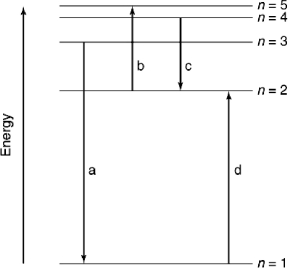
A) a
B) b
C) c
D) d

A) a
B) b
C) c
D) d

Unlock Deck
Unlock for access to all 143 flashcards in this deck.
Unlock Deck
k this deck
53
Early photoelectric light detectors were based on cesium. Cesium metal has a work function of 3.43 *10-19 J. What is the velocity of the photoelectrons ejected from a cesium surface when exposed to blue light at 400 nm?
A) 2.90 * 108 m/s
B) 2.90 *105 m/s
C) 5.81 * 102 m/s
D) 5.81 * 108 m/s
E) 5.81 *105 m/s
A) 2.90 * 108 m/s
B) 2.90 *105 m/s
C) 5.81 * 102 m/s
D) 5.81 * 108 m/s
E) 5.81 *105 m/s

Unlock Deck
Unlock for access to all 143 flashcards in this deck.
Unlock Deck
k this deck
54
The change in energy of a one-electron atom or ion for an electronic transition from the initial energy level ni to the final energy level nf is given by
E = -(2.18*10-18 J)
Z2
Which of the following species will have the longest wavelength emission line for the transition between the ni = 2 and nf = 1 levels?
A) H
B) He+
C) Li2+
D) Be3+
E) B4+
E = -(2.18*10-18 J)
Z2
Which of the following species will have the longest wavelength emission line for the transition between the ni = 2 and nf = 1 levels?
A) H
B) He+
C) Li2+
D) Be3+
E) B4+

Unlock Deck
Unlock for access to all 143 flashcards in this deck.
Unlock Deck
k this deck
55
Which transition in a hydrogen atom will cause emission of the shortest wavelength photon?
A) n1 = 4 to n2 = 3
B) n1 = 4 to n2 = 2
C) n1 = 3 to n2 = 2
D) n1 = 3 to n2 = 1
E) n1 = 10 to n2 = 9
A) n1 = 4 to n2 = 3
B) n1 = 4 to n2 = 2
C) n1 = 3 to n2 = 2
D) n1 = 3 to n2 = 1
E) n1 = 10 to n2 = 9

Unlock Deck
Unlock for access to all 143 flashcards in this deck.
Unlock Deck
k this deck
56
Which transition in a hydrogen atom requires the largest change in energy?
A) n1 = 2 to n2 = 3
B) n1 = 2 to n2 = 4
C) n1 = 1 to n2 = 3
D) n1 = 1 to n2 = 2
E) n1 = 9 to n2 = 10
A) n1 = 2 to n2 = 3
B) n1 = 2 to n2 = 4
C) n1 = 1 to n2 = 3
D) n1 = 1 to n2 = 2
E) n1 = 9 to n2 = 10

Unlock Deck
Unlock for access to all 143 flashcards in this deck.
Unlock Deck
k this deck
57
Which of the following objects, all moving at the same speed, will have the largest de Broglie wavelength?
A) a proton
B) an electron
C) a bowling ball
D) a neon atom
E) a neutron
A) a proton
B) an electron
C) a bowling ball
D) a neon atom
E) a neutron

Unlock Deck
Unlock for access to all 143 flashcards in this deck.
Unlock Deck
k this deck
58
What wavelength of light is required to cause the ejection of photoelectrons with kinetic energies of 5.0 *10-20 J from a calcium surface ( = 4.60 * 10-19 J)?
= 4.60 * 10-19 J)?
A) 485 nm
B) 390 nm
C) 308 nm
D) 632 nm
E) 480 nm
 = 4.60 * 10-19 J)?
= 4.60 * 10-19 J)?A) 485 nm
B) 390 nm
C) 308 nm
D) 632 nm
E) 480 nm

Unlock Deck
Unlock for access to all 143 flashcards in this deck.
Unlock Deck
k this deck
59
How much energy is required to ionize one mole of hydrogen atoms in their ground state?
A) 1,312 kJ
B) 2.18 kJ
C) 218 kJ
D) 2,178 kJ
E) 131.2 kJ
A) 1,312 kJ
B) 2.18 kJ
C) 218 kJ
D) 2,178 kJ
E) 131.2 kJ

Unlock Deck
Unlock for access to all 143 flashcards in this deck.
Unlock Deck
k this deck
60
The energy of a one-electron atom is given by E = -(2.18 *10-18 J) where Z is the atomic number of the element. Which of the following one-electron ions has the largest ionization energy?
A) Li2+
B) Be3+
C) He+
D) B4+
E) C5+
A) Li2+
B) Be3+
C) He+
D) B4+
E) C5+

Unlock Deck
Unlock for access to all 143 flashcards in this deck.
Unlock Deck
k this deck
61
A shell is defined by ________
A) the
Quantum number.
B) the ml quantum number.
C) the ms quantum number.
D) the n quantum number.
E) both the
And ml quantum numbers.
A) the
Quantum number.
B) the ml quantum number.
C) the ms quantum number.
D) the n quantum number.
E) both the
And ml quantum numbers.

Unlock Deck
Unlock for access to all 143 flashcards in this deck.
Unlock Deck
k this deck
62
Which subshell only has five orbitals?
A) = 2
B) = 1
C) = 5
D) = 3
E) = 4
A) = 2
B) = 1
C) = 5
D) = 3
E) = 4

Unlock Deck
Unlock for access to all 143 flashcards in this deck.
Unlock Deck
k this deck
63
What is the speed of an argon atom that has a de Broglie wavelength of 5.2 pm?
A) 0.52 m/s
B) 5.2* 103 m/s
C) 1.9 *103 m/s
D) 1.9 m/s
E) 25 m/s
A) 0.52 m/s
B) 5.2* 103 m/s
C) 1.9 *103 m/s
D) 1.9 m/s
E) 25 m/s

Unlock Deck
Unlock for access to all 143 flashcards in this deck.
Unlock Deck
k this deck
64
Which statement A-D about the wave function for a single electron is not correct?
A) A French graduate student named Louis de Broglie first had the idea that an electron should be described as a wave
B) Louis de Broglie postulated that the wavelength of an electron is given in terms of Planck's constant and its momentum, = h/p.
C) The square of the amplitude of the wave function at a particular point in space gives the probability density of finding the electron at that point.
D) An electronic wave function can never be 0 because that would mean the electron does not exist.
E) Statements A-D are all correct.
A) A French graduate student named Louis de Broglie first had the idea that an electron should be described as a wave
B) Louis de Broglie postulated that the wavelength of an electron is given in terms of Planck's constant and its momentum, = h/p.
C) The square of the amplitude of the wave function at a particular point in space gives the probability density of finding the electron at that point.
D) An electronic wave function can never be 0 because that would mean the electron does not exist.
E) Statements A-D are all correct.

Unlock Deck
Unlock for access to all 143 flashcards in this deck.
Unlock Deck
k this deck
65
In quantum mechanics, an atomic orbital ________
A) provides the position of an electron at any instant of time in the space around an atomic nucleus.
B) locates all the electrons in an atom.
C) is identical to the orbits Bohr used in his analysis of the hydrogen atom.
D) identifies the most probable position of an atomic nucleus.
E) provides the probability of finding an electron at any point in the space around an atomic nucleus.
A) provides the position of an electron at any instant of time in the space around an atomic nucleus.
B) locates all the electrons in an atom.
C) is identical to the orbits Bohr used in his analysis of the hydrogen atom.
D) identifies the most probable position of an atomic nucleus.
E) provides the probability of finding an electron at any point in the space around an atomic nucleus.

Unlock Deck
Unlock for access to all 143 flashcards in this deck.
Unlock Deck
k this deck
66
Which statement A-D about the wave function for a single electron is not correct?
A) A French graduate student named Louis de Broglie first had the idea that an electron should be described as a wave.
B) Since = c, an expression for the wavelength of an electron can be found by combining Einstein's equation that relates mass and energy (E = mc2) with his equation that gives the energy of a photon in terms of its frequency (E = 11ef1a67_6eab_04e9_a3cb_813dba8b61e6_TB3834_11).
= c, an expression for the wavelength of an electron can be found by combining Einstein's equation that relates mass and energy (E = mc2) with his equation that gives the energy of a photon in terms of its frequency (E = 11ef1a67_6eab_04e9_a3cb_813dba8b61e6_TB3834_11).
C) The square of the wave function's amplitude at a particular point in space gives the probability density of finding the electron at that point.
D) Wave functions can have nodes, which are points where the amplitude is zero.
E) Statements A-D are all correct.
A) A French graduate student named Louis de Broglie first had the idea that an electron should be described as a wave.
B) Since
 = c, an expression for the wavelength of an electron can be found by combining Einstein's equation that relates mass and energy (E = mc2) with his equation that gives the energy of a photon in terms of its frequency (E = 11ef1a67_6eab_04e9_a3cb_813dba8b61e6_TB3834_11).
= c, an expression for the wavelength of an electron can be found by combining Einstein's equation that relates mass and energy (E = mc2) with his equation that gives the energy of a photon in terms of its frequency (E = 11ef1a67_6eab_04e9_a3cb_813dba8b61e6_TB3834_11).C) The square of the wave function's amplitude at a particular point in space gives the probability density of finding the electron at that point.
D) Wave functions can have nodes, which are points where the amplitude is zero.
E) Statements A-D are all correct.

Unlock Deck
Unlock for access to all 143 flashcards in this deck.
Unlock Deck
k this deck
67
Which statement about the quantum numbers that identify an atomic orbital is not correct?
A) The angular momentum quantum number,
, identifies the shape of an orbital.
B) The value of the angular momentum quantum number can range from 0 to n, where n is the principal quantum number for the orbital.
C) Orbitals with the same value for the principal quantum number and the angular momentum quantum number are said to be in the same subshell.
D) Orbitals with the same values for the principal quantum number and the angular momentum quantum number have the same energy.
E) The value for the angular momentum quantum number also is designated by a letter:
S = 0, p = 1, d = 2, f = 3, etc.
A) The angular momentum quantum number,
, identifies the shape of an orbital.
B) The value of the angular momentum quantum number can range from 0 to n, where n is the principal quantum number for the orbital.
C) Orbitals with the same value for the principal quantum number and the angular momentum quantum number are said to be in the same subshell.
D) Orbitals with the same values for the principal quantum number and the angular momentum quantum number have the same energy.
E) The value for the angular momentum quantum number also is designated by a letter:
S = 0, p = 1, d = 2, f = 3, etc.

Unlock Deck
Unlock for access to all 143 flashcards in this deck.
Unlock Deck
k this deck
68
According to de Broglie, if the circumference of the electron's orbit in the hydrogen atom is twice the electron's wavelength, the orbit will ________
A) decay until the electron falls into the nucleus.
B) diverge, allowing the electron to escape.
C) be stable.
D) cause the electron to emit a photon.
E) not be circular.
A) decay until the electron falls into the nucleus.
B) diverge, allowing the electron to escape.
C) be stable.
D) cause the electron to emit a photon.
E) not be circular.

Unlock Deck
Unlock for access to all 143 flashcards in this deck.
Unlock Deck
k this deck
69
Which statement A-D about the wave function for a single electron is not correct?
A) A French graduate student named Louis de Broglie first had the idea that an electron should be described as a wave.
B) Louis de Broglie postulated that the wavelength of an electron is given in terms of Planck's constant and its momentum, = h/p.
C) The amplitude of a wave function at a particular point in space equals the probability density of finding the electron at that point.
D) Wave functions can have nodes, which are points where the amplitude is zero.
E) Statements A-D are all correct.
A) A French graduate student named Louis de Broglie first had the idea that an electron should be described as a wave.
B) Louis de Broglie postulated that the wavelength of an electron is given in terms of Planck's constant and its momentum, = h/p.
C) The amplitude of a wave function at a particular point in space equals the probability density of finding the electron at that point.
D) Wave functions can have nodes, which are points where the amplitude is zero.
E) Statements A-D are all correct.

Unlock Deck
Unlock for access to all 143 flashcards in this deck.
Unlock Deck
k this deck
70
De Broglie reasoned that for the electron in the hydrogen atom to behave as a stable circular wave, the circumference of the electron's orbit must be ________
A) equal to the wavelength of the electron.
B) an integer multiple of the electron's wavelength.
C) a half integer multiple of the electron's wavelength.
D) twice the wavelength of the electron.
E) twice the diameter of the orbit.
A) equal to the wavelength of the electron.
B) an integer multiple of the electron's wavelength.
C) a half integer multiple of the electron's wavelength.
D) twice the wavelength of the electron.
E) twice the diameter of the orbit.

Unlock Deck
Unlock for access to all 143 flashcards in this deck.
Unlock Deck
k this deck
71
The mathematical description of an electron as a wave was developed by ________
A) Bohr.
B) Heisenberg.
C) Einstein.
D) De Broglie.
E) Schrödinger.
A) Bohr.
B) Heisenberg.
C) Einstein.
D) De Broglie.
E) Schrödinger.

Unlock Deck
Unlock for access to all 143 flashcards in this deck.
Unlock Deck
k this deck
72
Which of the following electrons will have the smallest de Broglie wavelength?
A) an electron moving 220 m/sec
B) an electron moving 20 mi/hr
C) an electron moving 75 km/hr
D) an electron moving at 25% the speed of light
E) an electron at rest with no velocity
A) an electron moving 220 m/sec
B) an electron moving 20 mi/hr
C) an electron moving 75 km/hr
D) an electron moving at 25% the speed of light
E) an electron at rest with no velocity

Unlock Deck
Unlock for access to all 143 flashcards in this deck.
Unlock Deck
k this deck
73
Recently, buckyballs (C60) became the largest objects with a measured de Broglie wavelength. If the mass of a C60 molecule is 1.20 *10-24 kg, what will be its de Broglie wavelength if it is moving at a speed of 220 m/sec?
A) 2.52 pm
B) 2.52 fm
C) 2.52 m
D) 1.20 pm
E) 5.22 m
A) 2.52 pm
B) 2.52 fm
C) 2.52 m
D) 1.20 pm
E) 5.22 m

Unlock Deck
Unlock for access to all 143 flashcards in this deck.
Unlock Deck
k this deck
74
A shell consists of all ________
A) electrons with the same
Quantum number.
B) orbitals with the same quantum numbers.
C) orbitals with the same principal quantum number.
D) electrons with the same magnetic quantum number.
E) orbitals with the same
And ml quantum numbers.
A) electrons with the same
Quantum number.
B) orbitals with the same quantum numbers.
C) orbitals with the same principal quantum number.
D) electrons with the same magnetic quantum number.
E) orbitals with the same
And ml quantum numbers.

Unlock Deck
Unlock for access to all 143 flashcards in this deck.
Unlock Deck
k this deck
75
Subshells are ________
A) orbitals with the same principal and angular momentum quantum numbers.
B) orbitals with the same principal quantum numbers.
C) orbitals with the same angular momentum quantum numbers.
D) orbitals with the same angular momentum and magnetic quantum numbers.
E) orbitals with the same spin quantum number.
A) orbitals with the same principal and angular momentum quantum numbers.
B) orbitals with the same principal quantum numbers.
C) orbitals with the same angular momentum quantum numbers.
D) orbitals with the same angular momentum and magnetic quantum numbers.
E) orbitals with the same spin quantum number.

Unlock Deck
Unlock for access to all 143 flashcards in this deck.
Unlock Deck
k this deck
76
How many orbitals are possible for the n = 2 shell?
A) 1
B) 2
C) 3
D) 4
E) 5
A) 1
B) 2
C) 3
D) 4
E) 5

Unlock Deck
Unlock for access to all 143 flashcards in this deck.
Unlock Deck
k this deck
77
A proton in a cyclotron has a velocity of 2 * 108 m/s, which is nearly the speed of light. The uncertainty in the velocity is 1%. What is the minimum uncertainty in the position of the proton in meters? The proton mass is 2 *10-27 kg.
A) 3 *10-11 m
B) 1 * 10-22 m
C) 1 *10-18 m
D) 3 *10-41 m
E) 1 *10-17 m
A) 3 *10-11 m
B) 1 * 10-22 m
C) 1 *10-18 m
D) 3 *10-41 m
E) 1 *10-17 m

Unlock Deck
Unlock for access to all 143 flashcards in this deck.
Unlock Deck
k this deck
78
How many orbitals that have the principal quantum number equal to 3 are there in an atom?
A) 2
B) 4
C) 9
D) 16
E) 18
A) 2
B) 4
C) 9
D) 16
E) 18

Unlock Deck
Unlock for access to all 143 flashcards in this deck.
Unlock Deck
k this deck
79
Which statement about the quantum numbers that identify an atomic orbital is not correct?
A) The principal quantum number, n, identifies the size of an atomic orbital.
B) The angular momentum quantum number,
, identifies the shape of an atomic orbital.
C) The magnetic quantum number, ml, identifies the orientation of the orbital in space.
D) The magnetic quantum number can have values that range from -
To +
In integer steps.
E) The principal quantum number alone, n, identifies the energy of an atomic orbital.
A) The principal quantum number, n, identifies the size of an atomic orbital.
B) The angular momentum quantum number,
, identifies the shape of an atomic orbital.
C) The magnetic quantum number, ml, identifies the orientation of the orbital in space.
D) The magnetic quantum number can have values that range from -
To +
In integer steps.
E) The principal quantum number alone, n, identifies the energy of an atomic orbital.

Unlock Deck
Unlock for access to all 143 flashcards in this deck.
Unlock Deck
k this deck
80
Which statement about the quantum numbers that identify an atomic orbital is not correct?
A) The principal quantum number, n, identifies the size and energy of an orbital.
B) The value of the principal quantum number can be 0 or a positive or negative integer.
C) Orbitals with the same value for the principal quantum number are said to be in the same shell.
D) Orbitals with larger values of the principal quantum number locate the electron farther from the atomic nucleus.
E) Orbitals with smaller values of the principal quantum number describe electrons with a lower energy.
A) The principal quantum number, n, identifies the size and energy of an orbital.
B) The value of the principal quantum number can be 0 or a positive or negative integer.
C) Orbitals with the same value for the principal quantum number are said to be in the same shell.
D) Orbitals with larger values of the principal quantum number locate the electron farther from the atomic nucleus.
E) Orbitals with smaller values of the principal quantum number describe electrons with a lower energy.

Unlock Deck
Unlock for access to all 143 flashcards in this deck.
Unlock Deck
k this deck



